Two identical springs are fixed at one end and masses 1kg and 4kg are suspended at their other ends. They are both strethced down form their mean position and let go simultaneously. If they are in the same phase after every 4 seconds then the springs constant k is
πNm
π2Nm
2πNm
given data is insufficient
The correct Answer is:B
To solve the problem, we need to determine the spring constant k based on the information provided about the two masses and their oscillation phases.
1. Understanding the System:
- We have two identical springs with masses m1=1kg and m2=4kg attached to them.
- Both masses are released from their mean position simultaneously.
2. Angular Frequency Calculation:
- The angular frequency ω for a mass-spring system is given by:
ω=√km
- For the mass m1=1kg:
ω1=√k1=√k
- For the mass m2=4kg:
ω2=√k4=√k2
3. Phase of the Masses:
- The phase of the first mass can be expressed as:
Phase1=ω1t=√kt
- The phase of the second mass can be expressed as:
Phase2=ω2t=√k2t
4. Condition for Same Phase:
- The problem states that the two masses are in the same phase after every 4 seconds. This means the phase difference must be an integer multiple of 2π:
Phase1−Phase2=n⋅2π
- Substituting the expressions for the phases:
√kt−√k2t=n⋅2π
- Simplifying this gives:
(√k−√k2)t=n⋅2π
√k2t=n⋅2π
5. Finding the Time Interval:
- We know that the time interval t for the same phase is given as 4 seconds:
√k2⋅4=n⋅2π
- Rearranging gives:
√k=n⋅2π2
√k=n⋅π
6. Determining k:
- The first time they are in phase (for n=1):
√k=π⟹k=π2
Conclusion:
The spring constant k is π2.
- We have two identical springs with masses m1=1kg and m2=4kg attached to them.
- Both masses are released from their mean position simultaneously.
- The angular frequency ω for a mass-spring system is given by:
ω=√km
- For the mass m1=1kg:
ω1=√k1=√k
- For the mass m2=4kg:
ω2=√k4=√k2
- The phase of the first mass can be expressed as:
Phase1=ω1t=√kt
- The phase of the second mass can be expressed as:
Phase2=ω2t=√k2t
- The problem states that the two masses are in the same phase after every 4 seconds. This means the phase difference must be an integer multiple of 2π:
Phase1−Phase2=n⋅2π
- Substituting the expressions for the phases:
√kt−√k2t=n⋅2π
- Simplifying this gives:
(√k−√k2)t=n⋅2π
√k2t=n⋅2π
- We know that the time interval t for the same phase is given as 4 seconds:
√k2⋅4=n⋅2π
- Rearranging gives:
√k=n⋅2π2
√k=n⋅π
- The first time they are in phase (for n=1):
√k=π⟹k=π2
The spring constant k is π2.
Topper's Solved these Questions
- SIMPLE HARMONIC MOTIONBOOK - ALLENCHAPTER - SIMPLE HARMONIC MOTIONEXERCISE - Exercise- 3 Match The Column
1 Video
- SIMPLE HARMONIC MOTIONBOOK - ALLENCHAPTER - SIMPLE HARMONIC MOTIONEXERCISE - Asseration & Reason
7 Videos
- SIMPLE HARMONIC MOTIONBOOK - ALLENCHAPTER - SIMPLE HARMONIC MOTIONEXERCISE - Exercise-01
117 Videos
- RACEBOOK - ALLENCHAPTER - RACEEXERCISE - Basic Maths (Wave Motion & Dopplers Effect) (Stationary waves & doppler effect, beats)
25 Videos
- TEST PAPERBOOK - ALLENCHAPTER - TEST PAPEREXERCISE - PHYSICS
4 Videos
Similar Questions
spring of force constant k clamped rigidly at onoe end and a mass m attached to its free end. A force F applied at the free end stretches the spring. Figure shows the same spring with both ends free and attached to a mass m at either end. Each end of the spring in figure is stretched by the same force F.
(a) What is the maximum extension of the spring in the two cases ?
(b) If the mass in figure and the two masses in figure are released free, what is the period of oscillation in each case?

View SolutionTwo identical springs of spring constant k are attached to a block of mass m and to fixed supports as shown in figure. When the mass is displaced from equilibrium position by a distance x towards right, find the restoring force.

View Solution
Knowledge Check
Two springs fixed at one end are stretched by 4 cm and 12 cm, respectively, when masses of 0.5 kg and 1 kg are suspended at their lower ends. They are displaced slightly from their mean positions and released. What is the ratio of their periods of oscillation ?
A1:√2B1:2C1:√3D2:5From the fixed pulley, masses 2kg, 1kg and 3kg are suspended as shown in the figure. Find the extension in the spring if k=100N/m. (Neglect oscillations due to spring)
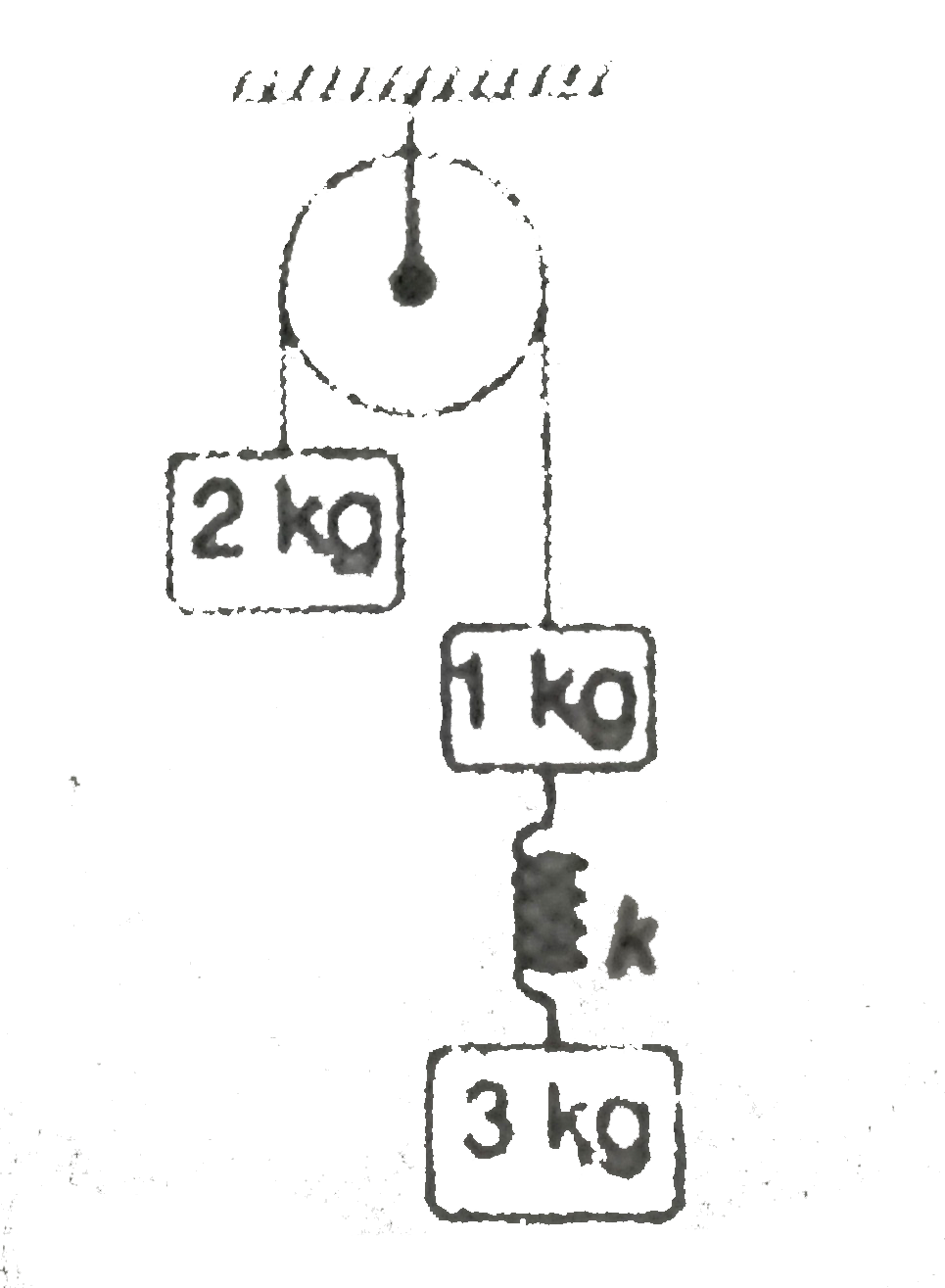 A0.1mB0.2mC0.3mD0
A0.1mB0.2mC0.3mD0A bead of mass m can slide without friction on a fixed circular horizontal ring of radius 3R having a centre at the point C. The bead is attached to one of the ends of spring of spring constant k. Natural length of spring is R and the other end of the spring is R and the other end of the spring is fixed at point O as shown in the figure. If the bead is released from position A, then the kinetic energy of the bead when it reaches point B is
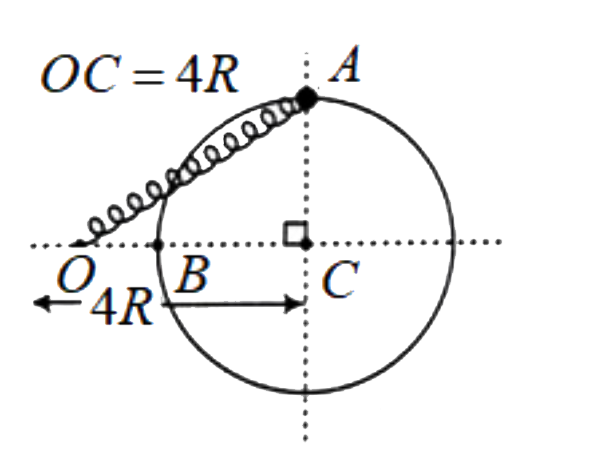 A252kR2B92kR2C8kR2D12KR2
A252kR2B92kR2C8kR2D12KR2
A light pulley is suspended at the lower end of a spring of constant k1, as shown in figure. An inextensible string passes over the pulley. At one end of string a mass m is suspended, the other end of the string is attached to another spring of constant k2. The other ends of both the springs are attached to rigid supports, as shown. Neglecting masses of springs and any friction, find the time period of small oscillations of mass m about equilibrium position.
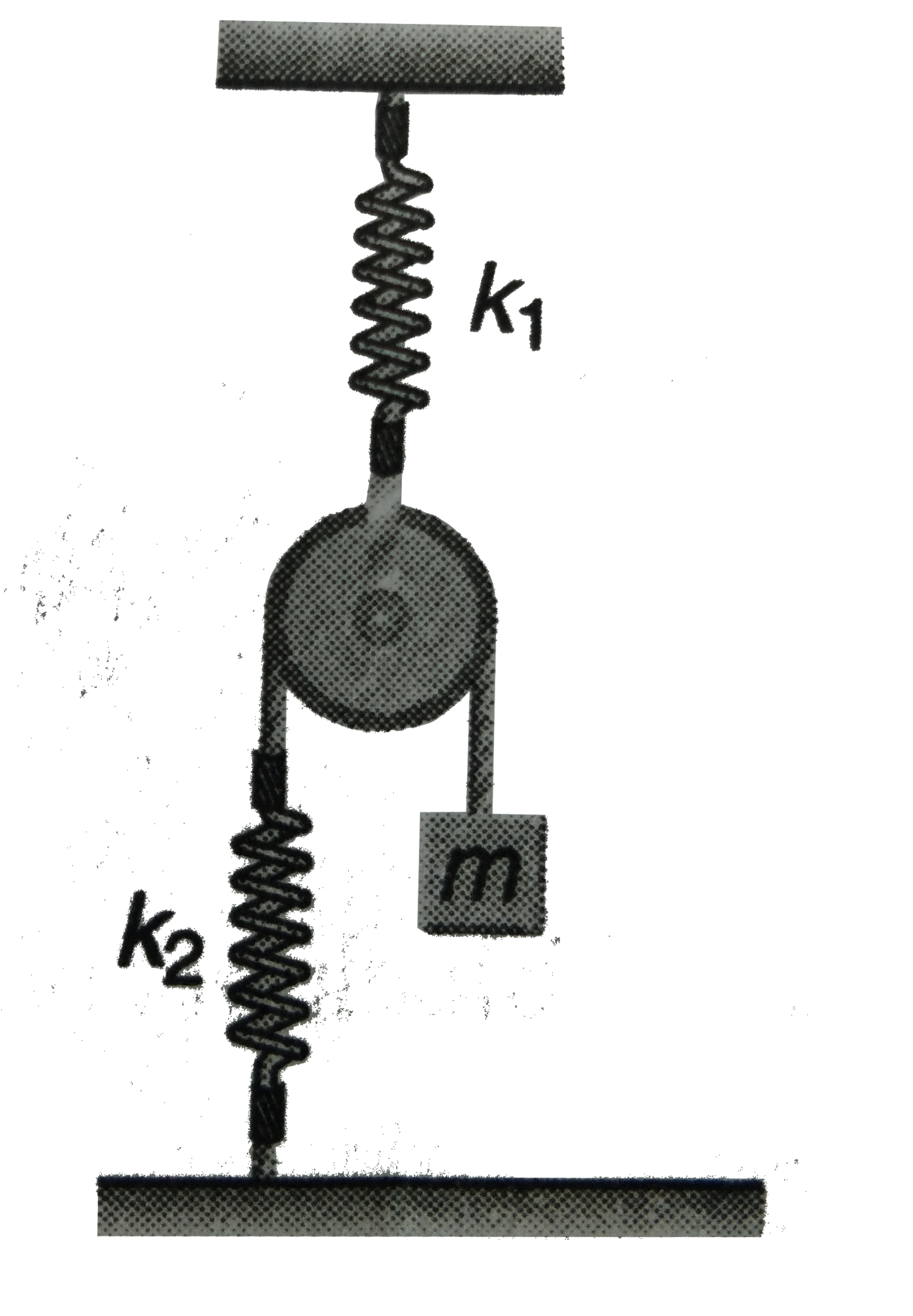
View SolutionA body of mass m is suspended from vertical spring and is set into simple harmonic oscillations of time period T. Next the spring is fixed at one end on a smooth horizontal table and same body is attached at the other end. The body is pulled slightly and then released to produce horizontal oscillations of the spring. The time period of horizontal oscillations is
View SolutionA particles of mass m is fixed to one end of a light spring of force constant k and unstreatched length l. the system is rotated about the other end of the spring with an angular velocity ω in gravity free space. The increase in length of the spring is
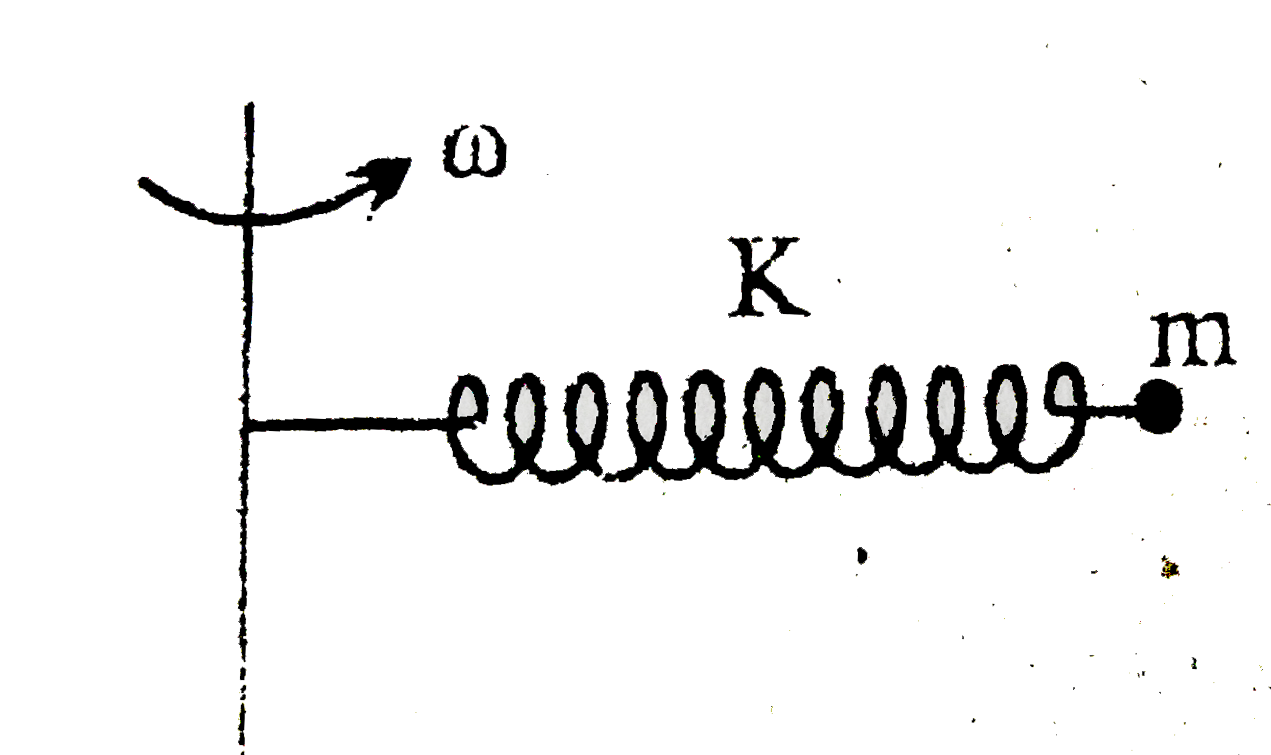
View Solution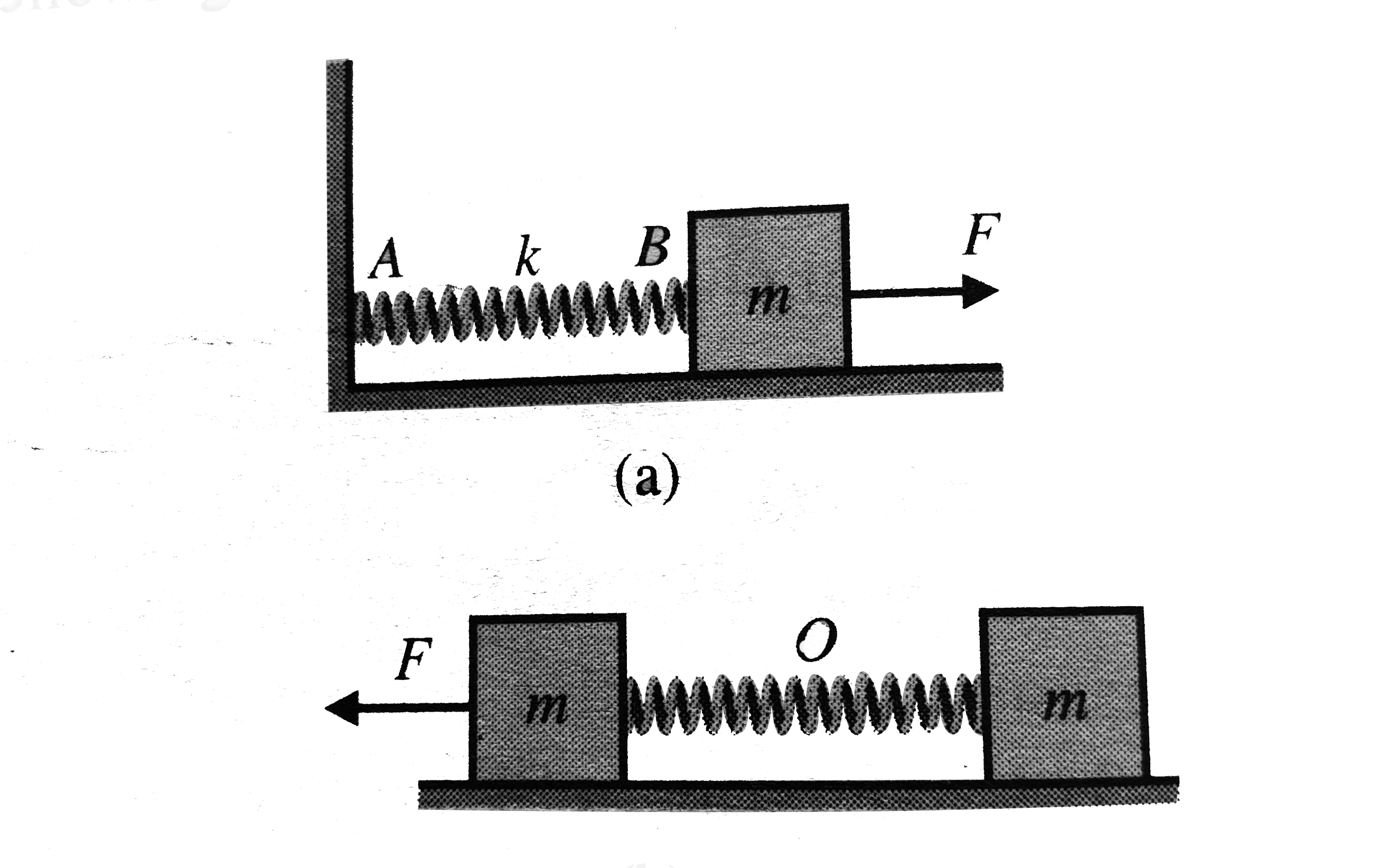
Figure. (a) shows a spring of force constant k fixed at one end and carrying a mass m at the other end placed on a horizontal frictionless surface. The spring is stretched by a force F. Figure. (b) shows the same spring with both endsf free and a mass m fixed at each free end Each of the spring is streched by the same force F. The mass in case (a) and the masses in case (b) are then released. Which of the following statements are true?
View SolutionA spring has a force constant k and a mass m is suspended from it the spring is cut in two equal halves and the same mass is suspended from one of the halves. If the frequency of oscillation in the first case is n, then the frequency in the second case will be
View Solution